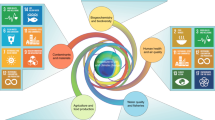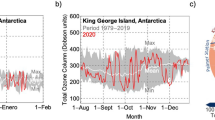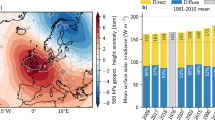Abstract
During recent years there have been suggestions1– that man's activities might reduce the thickness of the atmospheric ozone layer. Reductions in ozone could then give rise to an increase in potentially harmful solar UV radiation at the Earth's surface. Concern has been expressed particularly about the possibility of subsequent increases in skin cancer. Most calculations of ozone reduction have employed one-dimensional (height-only) models and few have calculated the solar radiation reaching the ground. Rather, it has been assumed that, for example, a 1 % depletion in ozone is equivalent to a 2 % increase in UV–B (the biologically important radiation in the wavelength range 280–320 nm) (refs 4, 5). However, studies using two-dimensional models6,7 indicate that any change in ozone will not be uniform, but will show significant variations with latitude and season. We show here first, that the commonly accepted idea that a depletion of ozone of a particular figure is equivalent to an UV increase of twice that figure does not hold generally; second, we point out the importance of seasonal and-latitudinal variations in ozone changes on the UV radiation reaching the Earth's surface.
This is a preview of subscription content, access via your institution
Access options
Subscribe to this journal
Receive 51 print issues and online access
$199.00 per year
only $3.90 per issue
Buy this article
- Purchase on Springer Link
- Instant access to full article PDF
Prices may be subject to local taxes which are calculated during checkout
Similar content being viewed by others
References
Johnston, H. S. Science 173, 517 (1971).
Molina, M. J. & Rowland, F. S. Nature 249, 810–812 (1974).
Crutzen, P. J. Ambio 3, 201–210 (1974).
Council on Environmental Quality, Fluorocarbons and the Environment (USGPO Washington DC, 1975).
Hammon, A. L. & Maugh, T. H. Science 186, 335–338 (1974).
Pyle, J. A. Nature 271, 42–43 (1978).
Pyle, J. A. WMO Publ. No. 511, 239–246 (1978).
Green, A. E. S., Sawada, T. & Shettle, E. P. Photochem. Photobiol. 19, 251–259 (1974).
Komhyr, W. D. & Machta, L. The Perturbed Troposphere of 1990 and 2020 (Department of Transportation, Washington DC, 1973).
Department of Environment, Chlorofluorocarbons and their Effect on Stratospheric Ozone (HMSO, London, 1979).
Author information
Authors and Affiliations
Rights and permissions
About this article
Cite this article
Pyle, J., Derwent, R. Possible ozone reductions and UV changes at the Earth's surface. Nature 286, 373–375 (1980). https://doi.org/10.1038/286373a0
Received:
Accepted:
Issue Date:
DOI: https://doi.org/10.1038/286373a0
This article is cited by
Comments
By submitting a comment you agree to abide by our Terms and Community Guidelines. If you find something abusive or that does not comply with our terms or guidelines please flag it as inappropriate.



